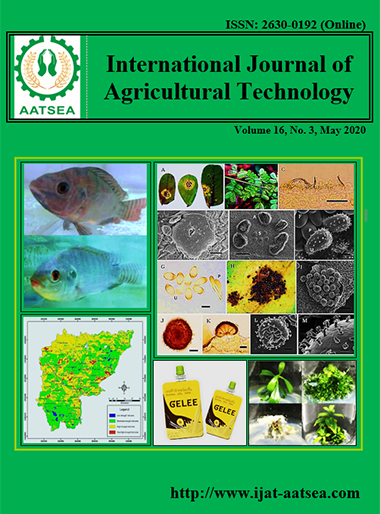A survey on acid hydrolysis in analyzing the monosaccharide composition of exopolysaccharide from Ophiocordyceps
Main Article Content
Abstract
Exopolysaccharide (EPS) is a heterogeneous group of polysaccharides which has diversed biological activities; in which monosaccharide composition is one of the crucial factors determining the biological activity of EPS. In the analysis of monosaccharide composition by GC-FID technique, the determination of proper acid is a significant step to help cut the glycosidic bond which is less stable in an acidic environment, great hydrolysis of polysaccharide chain to monosaccharide level, to form Acetyl derivatives. The hydrolysis ability of 3 acids: H2SO4, HCl, and Triflic acid for hydrolyzing EPS of Ophiocordyceps sinensis (O. sinensis). Hydrolysis ability was assessed by thin-layer chromatography and high-performance liquid chromatography (HPLC), then the product was treated by acetylation and finally analyzed by GC-FID to determine the monosaccharide composition of the EPS. The results showed that hydrolysis by H2SO4 gave higher hydrolysis efficiency and was more suitable than hydrolysis by HCl and Triflic acid in the pretreatment of EPS sample for monosaccharide composition analysis by GC-FID. H2SO4-treated EPS detected 5 types of monosaccharides: rhamnose, arabinose, mannose, glucose, and galactose; mainly mannose, galactose, and glucose; mannose portioned the highest percentage. The study has set the fundamental for further analysis of the chemical structure and biological activities of EPS.
Article Details

This work is licensed under a Creative Commons Attribution-NonCommercial-NoDerivatives 4.0 International License.
References
Belwal, T., Bhatt, I. D., Kashyap, D., Sak, K., Tuli, H. S., Pathak, R., Rawal, R. S. and Ghatnur, S. M. (2019). Ophiocordyceps sinensis. In Nonvitamin and Nonmineral Nutritional Supplements. Academic Press, pp. 527-537.
Cha, S. H., Lim, J. S., Yoon, C. S., Koh, J. H., Chang, H. I. and Kim, S. W. (2007). Production of mycelia and exo-biopolymer from molasses by Cordyceps sinensis 16 in submerged culture. Bioresource technology, 98:165-168.
Perepelov, A. V., Babicka, D., Sof'ya, N. S., Shashkov, A. S., Moll, H., Rozalski, A., Zähringer, U. and Knirel, Y. A. (2001). Structure of the O-specific Polysaccharide of Proteus vulgaris O4 Containing a New Component of Bacterial Polysaccharides, 4, 6-dideoxy-4-N-[(R)-3-hydroxybutyryl]-l-alanyl amino-d-glucose. Carbohydrate Research, 331:195-202.
Radchenkova, N., Tomova, A. and Kambourova, M. (2011). Biosynthesis of an exopolysaccharide produced by Brevibacillus thermoruber 438. Biotechnology & Biotechnological Equipment, 25:77-79.
Selvendran, R. R., March, J. F. and Ring, S.G. (1979). Determination of aldoses and uronic acid content of vegetable fiber. Analytical biochemistry, 96:282-292.
Soltani, M., Kamyab, H. and El-Enshasy, H. A. (2013). Molecular Weight (Mw) and Monosaccharide Composition (MC): Two Major Factors Affecting the Therapeutic Action of Polysaccharides Extracted from Cordyceps sinensis. Journal of Pure and Applied Microbiology, 7:1601-1613.
Trang, V. T. P. (2018). Study on methods of obtaining exopolysaccharide fractions from Ophiocordyceps sinensis culture. (Master Thesis). VNUHCM-University of Science, Ho Chi Minh city, Vietnam. (In Vietnamese).
UÇAR, G. and Balaban, M. (2004). Hydrolysis of polysaccharides with 77% sulfuric acid for quantitative saccharification. Turkish Journal of Agriculture and Forestry, 27:361-365.
Yan, J. K., Wang, W. Q. and Wu, J. Y. (2014). Recent advances in Cordyceps sinensis polysaccharide: Mycelial fermentation, isolation, structure, and bioactivities: A review. Journal of Functional Foods, 6:33-47.
Yu, G., Guan, H., Ioanoviciu, A. S., Sikkander, S. A., Thanawiroon, C., Tobacman, J. K., Toida, T. and Linhardt, R. J. (2002). Structural studies on κ-carrageenan derived oligosaccharides. Carbohydrate Research, 337:433-440.
Yuan, Y., Wang, Y. B., Jiang, Y., Prasad, K. N., Yang, J., Qu, H., Wang, Y., Jia, Y., Mo, H. Yang, B. (2016). Structure identification of a polysaccharide purified from Lycium barbarium fruit. International journal of biological macromolecules, 82:696-701.
Zha, X. Q., Xiao, J. J., Zhang, H. N., Wang, J. H., Pan, L. H., Yang, X. F. and Luo, J. P. (2012). Polysaccharides in Laminaria japonica (LP): Extraction, physicochemical properties and their hypolipidemic activities in diet-induced mouse model of atherosclerosis. Food chemistry, 134:244-252.
Zhang, J., Yu, Y., Zhang, Z., Ding, Y., Dai, X. and Li, Y. (2011). Effect of polysaccharide from cultured Cordyceps sinensis on immune function and anti-oxidation activity of mice exposed to 60Co. International Immunopharmacology, 11:2251-2257.
Zhang, W., Yang, J., Chen, J., Hou, Y. and Han, X. (2005). Immunomodulatory and antitumour effects of an exopolysaccharide fraction from cultivated Cordyceps sinensis (Chinese caterpillar fungus) on tumour‐bearing mice. Biotechnology and applied biochemistry, 42:9-15.


